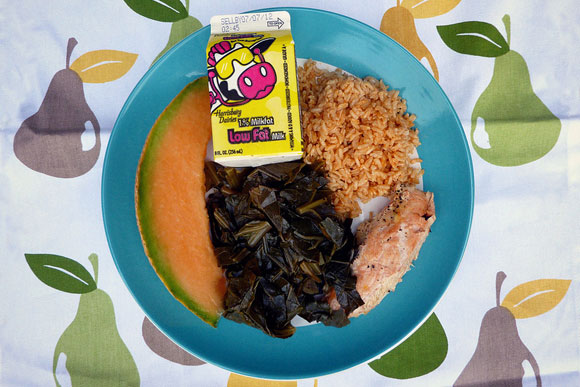Though gorgeous weather during the first week of school can be a sore spot for students in the District, it happens to be a boon for the outdoor aspects of their education. These days, that category includes not only recess but, for many, a school garden.
Nearly half of all schools in the District have school garden programs, up 15 percent from the previous school year, says Karissa McCarthy, farm-to school-coordinator for the nonprofit
DC Greens.
And inside the schools, more students are getting access to local and healthful foods through a combination of successful farm-to-school programs and new federal requirements about what’s on their plates.
For a city that’s lagged parts of the country in the farm-to-table movement (which it’s now embraced with gusto), the District has been a leader in farm-to-school policies. D.C. passed an act in 2010 that gives schools an extra 5 cents per meal if local ingredients are used.
“That’s pretty rare. The only other city that does that is Portland, Oregon,” says McCarthy.
New programs are working to strengthen the link between what happens in the gardens and what’s served in the lunchrooms, whether that means reimagining local food distribution or simply showing kids how to make a kale salad.
But, as any nonprofit or volunteer that works in this space will tell you, there’s always more work to be done — and only sometimes the funding to do it.
Kristy McCarron was part of a “dream” program at DCPS's Walker Jones Education Campus (grades pre-K through 12) last year, where she worked as a culinary instructor for the school’s
Food Lab. There, she turned a sizable school garden into edible education for the classrooms, weaving garden-based meals and snacks into math and social studies and teaching the kids where food comes from.
But the position lost some key funding that had come from a hodgepodge of grants, and McCarron said it was no longer financially sustainable for her.
“It really comes down to funding,” says McCarron, who now works in a similar position with the YMCA in the District. “If [DCPS] had caught on to what we were doing and piloted programs through the school district, it could have been wildly successful.”
DCPS did hire its first full-time garden coordinator at
Benjamin Stoddert Elementary School this year and has 39 part-time coordinators who often work alongside volunteers.

A program similar to the Food Lab, called
FoodPrints, has taken root at Watkins Elementary School (grades 1-5), run by FRESHFARM Markets and funded by donations and foundations. FRESHFARM raised $60,000 through a
Kickstarter campaign in 2011 to renovate the program’s classroom into a Food Lab that facilitates cooking.
Cooking demonstrations have become key to tying school gardens to school food, since most gardens do not meet federal standards — not to mention quantities — for their produce to be used in school lunches. But McCarthy says more schools are rethinking how they can put their produce to use outside of school lunches.
DC Greens is launching a school garden market at six area schools this month where parents and community members can buy produce that students "helped" grow.
“Our hope is that this not only showcases what’s going on in school gardens but also provides needed fruits and vegetables in communities that have a lack of access,” McCarthy says.
The seasonal problem
Some of the money that’s been made available to address farm to school’s most vexing problems has gone to D.C.-based innovators and institutions. Nearly $100,000 from the USDA’s first batch of farm-to-school grants last year went to
D.C. Central Kitchen, a multi-pronged nonprofit that, besides feeding and employing the homeless and poor, now serves 5,500 meals a day at eight public schools in the District, using food from local farms.
The grant helped the organization build a second facility with a kitchen, expansive walk-in freezers and a produce-washing system that makes it that much easier to turn donations from local farms into meals. The freezers help them extend the bounty that's available in the summer into more of the school year.
By the beginning of last year, DCCK had increased its local farm spending by 40 percent, investing $43,500 with local farmers, says Alex Moore, director of development.
"Our hope is this not only showcases what�s going on in school gardens but also provides needed fruits and vegetables in communities."
A big part of that increase, he says, comes from increasing the amount of produce kids are willing to eat. DCCK looked at what students were throwing away and conducted taste tests to see how they could improve the appeal of local produce.
“We doubled sweet potato consumption by adding cinnamon,” Moore says. “These are the sort of marginal improvements that we’re focused on.”
While farm to school programs like these have made great strides in recent years, Moore said many of the original obstacles remain.
Getting food from D.C.’s farm belt instead of from across the country — in quantities that can feed thousands of kids a day — continues to be the next frontier for innovation in this scene.
The
Arcadia Center for Sustainable Food & Agriculture is in the process of creating a
Food Hub, one that could help fill the gaps in local food distribution. It would work with farms within 150 miles of D.C. to aggregate and distribute their produce to restaurants, markets and institutional buyers like schools, says Matt Mulder, Arcadia’s director of development and communication.
The nonprofit already works in tandem with D.C. schools to host field trips at its farm in Alexandria. Arcadia also runs a Mobile Market bus that brings produce into District neighborhoods that might not otherwise have access.
“The work we’ve done with farm to school shows us that, when it comes to actually putting food on the plate… you really need to change distribution if you want to make an impact,” says Mulder.